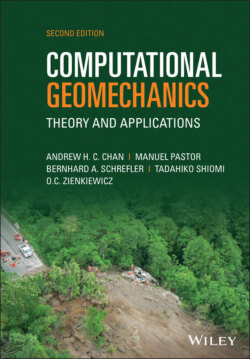Читать книгу Computational Geomechanics - Manuel Pastor - Страница 18
2.1 General Remarks on the Presentation
ОглавлениеIn this chapter, we shall introduce the reader to the equations which govern both the static and dynamic phenomena in soils containing pore fluids. We shall divide the presentation into three sections: Section 2.2 will deal with soil, or indeed any other porous medium, saturated with a single fluid. This most common problem contains all the essential features of soil behavior and the equations embrace and explain the vast majority of problems encountered in practice.
We shall show here how the dynamic equations, which are essential for the study of earthquakes, reduce to those governing the quasi‐static situations of consolidating soils and indeed to purely static problems without modification. This feature will be used when discretization is introduced and computer codes are derived since a single code will be capable of dealing with most phenomena encountered in soil and rock mechanics.
The limitations of the approximating simplification are discussed in Section 2.2 by using a simple linearized example and deriving conclusions on the basis of an available analytical solution. The same discussion will show the domain of the validity of the assumptions of undrained and fully drained behavior.
In the same section, we shall introduce a simplification which is valid for the treatment of most low‐frequency phenomena – and this simplified form will be used in the subsequent Section 2.3 dealing with partially saturated soil in which the air pressure is assumed constant and also, finally, in Section 2.4 dealing with simultaneous water and airflow in the pores.
The notation used throughout this chapter will generally be of standard, tensorial form. Thus:
Alternatively, the form
will also be used for the same quantity in vectorial notation.
Similarly, we shall use wi and vi or w and v to denote the velocities of water and air relative to the solid components. These velocities are calculated on the basis of dividing the appropriate flow by the total cross sectional area of the solid–fluid composite.
As mentioned in Chapter 1, σij and refer to the appropriate total and effective stresses, with σ and σ ″ being the vectorial alternatives.
Similarly, εij or ε refers to the strain components. Further, pa, pw, and p = χw pw + χa pa will stand for air and water pressure and the “effective” pressure defined in the effective stress concept in Equation (1.11) when two fluids are present.
Sa and Sw are the relative degrees of saturation and ka and kw are the permeabilities for air and water flow.
Other symbols will be added and defined in the text as the need arises.
The derivation of the equations in this chapter follows a physical approach which establishes clearly the interactions involved in the manner presented by Zienkiewicz and Shiomi (1984), Zienkiewicz (1982), Zienkiewicz et al. (1990a, 1990b), etc. This is a slightly different approach from that used in the earlier presentations of Biot (1941, 1955, 1956a, 1956b, 1962) and Biot and Willis (1957) but we believe it is slightly easier to follow as it explores the physical meaning of each term.
Later, it became fashionable to derive the equations in the form of the so‐called mixture theories (see Green and Adkin 1960; Green 1969; Bowen 1976). The equations derived were subsequently recast in varying forms. Here an important step forward was introduced by Morland (1972) who used extensively the concept of volume fractions. Derski (1978) introduced a different derivation of coupled equations and Kowalski (1979) compared various parameters occurring in Derski’s equations with those of Biot’s equations. A full discussion of the development of the theory is given in the paper by de Boer (1996).
For completeness, we shall include such mixture derivations of the equations in Section 2.5. If correctly applied, the mixture theory establishes, of course, identical equations with appropriately chosen parameters and rheological relations.
It seems that despite much sophistication of various sets of coupled equations, most authors limited their works to conventional, linear elastic, behavior of the solid. Indeed, de Boer and Kowalski (1983) found it necessary to develop a special plasticity theory for porous, saturated solids. In the equations of Zienkiewicz (1982) and Zienkiewicz et al. (1990a), any nonlinear behavior can be specified for the skeleton and, therefore, realistic models can be incorporated. Indeed we shall find that such models are essential if practical conclusions are to be drawn from this work.
